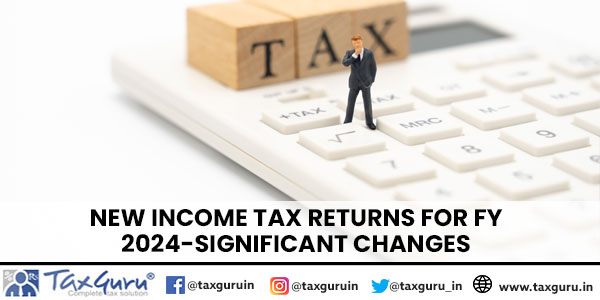Introduction: The Central Board of Direct Taxes (CBDT) has introduced new Income Tax Returns for the financial year 2024, impacting individuals and other assessees. This article delves into the noteworthy modifications across various ITR forms, highlighting implications for taxpayers.
ITR-1 (SUGAM): Resident individuals upto Rs. 50 lakhs income, agricultural income up to Rs. 5000/-and owning only one house property need to note the following:
Changes in ITR-1:
1. An assessee filing ITR 1 is only required to accept New Tax Regime as default option. Otherwise, he can opt out by filing Form 10-IEA under the Old Regime.
2. Resident Individual can file ITR 1 only if he owns only one residential property and his agricultural income is not more than Rs. 5,000/-
3. He is required to disclose all his bank accounts except dormant ones
4. A new column has been added to claim deduction under section 80CCH in new ITR Forms 1 for Agniveers.
ITR-2 : Individuals and HUFs having income >INR 50 Lakh with income as
- Capital gains
- More than one house property
- Foreign income
- Individual director of company
- Holding unlisted equity shares
Changes in ITR-2: Taxpayers now must provide additional details
1. Legal Entity Identifier (LEI) details are required for claiming refund of Rs. 50 lakhs and above.
2. Contributions made to political parties need to be disclosed, including the date and mode of payment under Section 80GGC.
3. Information on deductions claimed for the maintenance, including medical treatment, of a dependent who is a person with a disability is required under Section 80DD.
ITR-3 For individuals and HUFs having income from profits and gains of business or profession:

Changes in ITR-3:
1. FPI/FII: Must disclose SEBI registration number
2. Reporting income from Virtual Digital Assets (VDA)/crypto added under Capital Gains. Also, the quarterly breakdown in Capital Gain Schedule is asked for.
3. Advances received as per Section 40A(2)(b) from specified individuals and others to be reported under “Advance” Category in Source of Fund.
4. Turnover and income from intraday trading must be reported in the new section under the ‘Trading Account’ section.
5. Section 80U deduction requires details of nature of disability, details of filing of Form 10-IA and its acknowledgement number.
ITR -4: Individuals, HUFs and Firms (Excluding LLP) with annual income<50 lakh, opting for presumptive taxation
- Salaried individuals or pensioners
- Agricultural income up to INR 5000
- Individuals with presumptive income under Section 44AD, 44ADA or 44AE
Changes in ITR-4:
1. An assessee filing ITR 4 will be required to file Form 10-IEA to opt out of the new tax regime.
2. New column has been added to claim deduction under section 80CCH in new ITR Form 4.
3. The “Receipts in Cash” column has been added to ITR-4 to claim an enhanced turnover limit.
4. Under Section 44AD, turnover threshold is increased to Rs. 3 crores but cash receipt not exceeding 5%.
5. Under Section 44ADA, the limit is Rs. 75 lakhs.
6. Assessee need to disclose all bank accounts in India
Other Key Changes:
- In case of ITR-3, the individual and HUF can verify tax audit report through electronic verification code also.
- In case of ITR-3,5,6, the assessee shall specify the due date of return filing from drop down menu.
- Furnish the acknowledgement number for Audit Report and UDIN (ITR 3,5,6)
- Disclose the sum payable to MSME beyond the prescribed time limit (ITR 3,5,6)
- Disclose the comprehensive information pertaining to capital gains accounts scheme (ITR 2,3,5 & 6)
- Under Schedule 80GGC, details of contribution to political parties are sought in details. (ITR 2,3,5,6)
- Schedule Tax Deferred on ESOP seeks information as AY, amount of deferred tax brought forward, amount of tax payable in current financial year etc. The PAN and DPIIT registration number of eligible start ups are required to be disclosed. (ITR 2,3)
- Schedule OS included the declaration of bonus payment under LIC policies, details of receipt of dividend from IFSC units (ITR 2,3,5,6)
- Startups under Section 80-IAC- The Schedule seeks details date of incorporation, nature of business, certificate number obtained from Inter-Ministerial Board, First AY-when deduction claimed, amount of deduction claimed for current AY.(ITR 5 & 6)
- MSME details are required like registration status, registration number as allotted MSME (ITR 5 & 6).
Conclusion: The latest Income Tax Returns for FY 2024 entail substantial alterations aimed at enhancing compliance and transparency. From revised disclosure requirements in ITR-1 to additional details in ITR-3 for businesses and professionals, taxpayers must acquaint themselves with these changes to fulfill their tax obligations accurately. Furthermore, professionals like Chartered Accountants play a vital role in guiding taxpayers through these amendments and ensuring adherence to regulatory norms. For assistance with income tax returns, compliance, or litigation, individuals can reach out to qualified professionals for expert support and guidance.
*****
In case you have any concern and queries or need any support regarding income tax returns/compliance/litigation you may like to contact us.
Abhinarayan Mishra, FCA, FCS; KPAM & Associates, Chartered Accountants, Dwarka, New Delhi; +9910744992, ca.abhimishra@gmail.com






Since your income exceeds Rs. 50 lakhs, you may file your return in ITR-2. However, please take advice from a tax professional who will guide you after considering all your income.
Thank you
sir, Central Psu Insurance company agents need to select whichI TR
sir, how about pensioner of central PSU less than 59 lakhs need to select which ITR